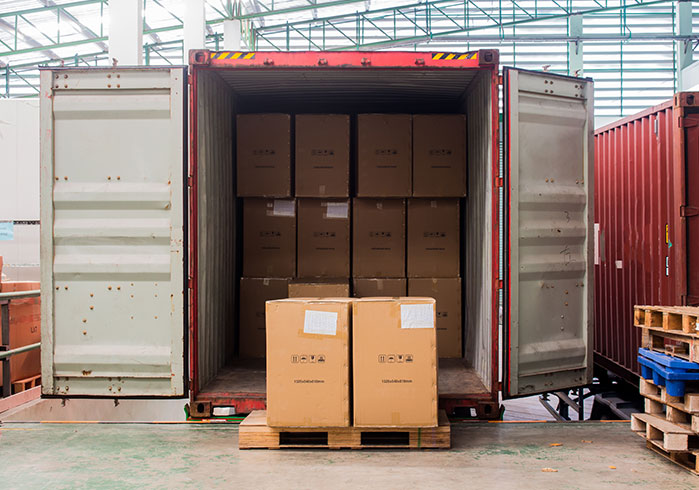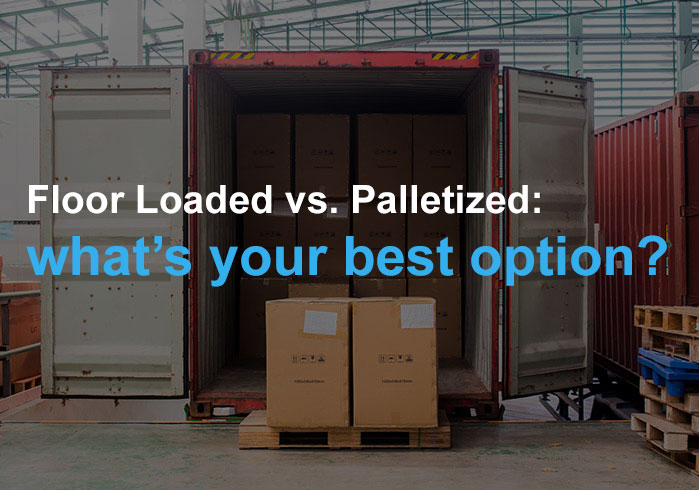
The choices that shippers have for shipping their freight is full truckload (FTL) and less than truckload (LTL). In most cases, the customer is not given the choice of whether to use palletized systems of floor-loaded ones. Nevertheless, the difference between these two approaches has significant cost implications.
Therefore, it makes sense for shippers to understand how both LTL and FTL can effect your Ecommerce fulfillment process and the associated costs. This article explains some of the key aspects of FTL and LTL. It also allows customers to make informed choices about floor-loaded and palletized shipping. Let us begin with key definitions.
Definitions
Floor loaded:
The floor-loaded container is defined as one in which the contents are loaded onto the floor of the container directly. It is a method of packing that is also known as floor stacking. Under this system, the container is filled from floor to ceiling with products.
Palletizing:
By contrast, palletization involves placing different boxes and products onto a pallet. The products are then held together using metal straps or plastic wraps. In that sense, the pallet is the base for a collection of products that are stuck together using tape.
Pros and cons
Each of these options has advantages and disadvantages as discussed below:
Floor Loaded, Pros and Cons:
Something to remember is that floor-loaded items reduce freight costs. The reason for this is the fact that the entire container is used to load products, rather than also having to pay for pallets. You are likely to require fewer containers to ship your product.
The downside is that this type of loading is not suitable for all products. For example, it is too risky for more delicate or fragile products. The chances of damage are increased in these cases. Instead, this system is used for heavy and bulky products such as tires, carpets, and pipes.
Bear in mind the additional labor costs that are involved in packing and unloading a freight shipment off the floor. There is also a time consideration because this is an involved process. Businesses must do a cost-benefit analysis in terms of time and labor cost before taking this option. All the shipments must be loaded and unloaded by hand in this case.
Palletizing, Pros, and Cons:
Most shippers tend to use pallets when sending cargo across the world, including the USA. Through palletization, it is possible to turn many smaller boxes into a single large unit. This unit is stronger than each individual box. That is why some consider this to be a more secure way of handling cargo.
Another advantage of pallets is that they elevate the cargo from the floor of the container during transit. This is a protective measure in case there is a water spillage into the container. Moreover, the fact that the pallets are standardized means that they can easily fit into containers since they have extremely specific dimensions.
The calculations of how many pallets are required are pre-set and there is no need to develop a complex algorithm for this purpose. Besides, the pallets are easy to move from place to place as you are loading or docking. Moreover, palletization can work for both LTL and FTL freight.
It is important to note that there are restrictions that are put in place by UPS and FedEx for those operating in the USA. These couriers will not pick up any pallets unless the shipment has used its in-house freight service. Moreover, FedEx Freight has made palletization mandatory for its transit services. However, UPS is still able to accept unpalletized boxes if you are using its in-house freight service.
Best Practices
There are certain techniques and approaches which have proved to be more successful than others when packing a pallet. Here are a few of them to consider for your freight shipment:
- Try to center all the boxes so that they cover the gaps between the boards in the pallet. This helps to avoid tipping or slipping.
- Ensure that the entirety of the load footprint is within the pallet edges.
- Try to stack all the items close together so that there is little space between the boxes.
- Wherever possible, use plastic to secure the load. This helps to put all the pallets into a single unit which is secure throughout transit.
- Whenever possible, aim for a square load.
- Never include empty boxes in the load because they can easily collapse and risk the rest of the load.
- Where an extra box is needed, you can pack it in tightly using infill.
Floor Loaded Best Practices
You must be thoughtful and organized when packing a floor load. Remember that this could be a mixed shipment. Bear in mind the fact that the heavier items are best put at the bottom while the lighter ones can be placed on the top.
Use straps and bars to keep the items in place. This is a replacement for the plastic that is used to hold pallets in one firm shape. The straps prevent movement during transit, which can cause damage to the products. Some larger containers have developed technologies for calculating the exact loads needed for a given space and remember that charges for overweight containers can be quite significant.
Palletizing Best Practices
When it comes to pallets, use the same principles of putting heavier items at the bottom. This is particularly important when dealing with a mixed shipment. Failure to do this can lead to pancaking during shipping and significant damage. Loads should be even without favoring one side or the other.
How to Choose: Floor Loaded vs. Palletizing
Think about your costs and the time that you have. Using pallets adds costs in terms of buying the pallets, but also saves time in loading and unloading. Using floor loads may initially not have the additional cost of a pallet, but it must be done by hand. That brings in labor costs and the time spent.
Some companies such as Amazon have expressed a preference for pallets. Amazon FBA, therefore, places significant restrictions on floor loading. A shipment can be declined for failing to meet all the requirements. For example, any box that is at least 50lbs must be palletized under the Amazon FBA contract. This allows for the use of a forklift. This is in line with the OSHA guidelines that require at least two warehouse workers to move any item that is at least 50lbs.
In most cases, pallets are excellent for e-Commerce shipping. The 3PL partners will process all the inbound shipments quickly and there are no additional processing charges. Moreover, the items are secure. This holds even when you are on multi-modal journeys. Pallets can easily be transferred from ship to truck or rail for further transit.
At other times, you may prefer floor loading. This could be because you have many items and want to minimize costs. It allows you to fill your container and gain maximum utility from it. The downside is the costs involved in loading and unloading. This type of loading works best for heavier, bulkier, and durable items. It can also work for items that are odd-shaped and cannot be put on pallets.
Wrapping Up Shippers have the option of either using pallets or using floor packing. Each comes with its risks and costs. Generally, pallets are compact, safe, and easy to move. However, they are also expensive. By way of contrast, floor loading allows for large items to be packed cheaply. The downside is the need for manual loading and unloading. A cost-benefit analysis will help you understand which option is best for you.



One Comment on ““Floor Loaded vs. Palletized: What’s Your Best Option?””
What are typical fill rates for floor loading vs pallet loads?
It sounds like loose-loading allows for more units per container/trailer, which translates to a lower transit per unit (admittedly offset by additional labour to load/unload) and also a lower carbon footprint per unit?